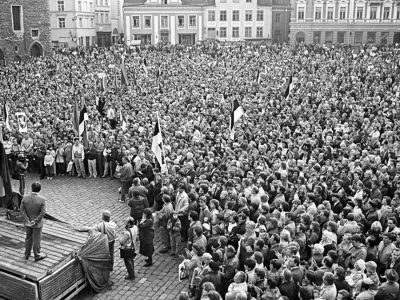With the death of Stalin in March 1953 and the soon-to-follow process of de-Stalinization under Khrushchev, socialist realism as a movement finally begins its slow succumb to scrutiny… but not without a lot of mixed signals and zig-zags from the Soviet … Continue reading →
Month: March 2017
The Virgin Lands Program
by •
After Stalin’s death, a period of reforms and changes began to take hold in the USSR. Among many changes and initiatives that took place, Khrushchev’s Virgin Lands Program was significant. The Virgin Lands Program was an “…ambitious scheme to convert
Shhhh… It’s a Secret (Speech)
by •
On February 24th, 1956 Premier Nikita Khrushchev delivered a Secret Speech to a closed session of the 20th Congress that set the course for the destalinization of the Soviet Union. No one knew Khrushchev had planned to give this speech, and no part of the session was made open to the public. However, the speech …
Mankind’s Deadliest Weapon: The Hydrogen Bomb
by •
In his essay Hydrogen Bomb, Lewis Siegelbaum states that on “August 12, 1953 the Soviet Union detonated a thermonuclear (“hydrogen”) bomb at the Semipalatinsk test site in northern Kazakhstan. Work on the super-bomb had begun in 1946, three years before the Soviet Union exploded its first atomic bomb.” To clarify, the difference between an atomic … Continue reading Mankind’s Deadliest Weapon: The Hydrogen Bomb![]()
Out With the Old (Prisoners)
by •
It is well known that Soviet citizens were often victims to incredibly harsh punishments for mediocre crimes: examples of trial worthy crimes are here and here. But on March 27, 1953 De-Stalinization reached the prisoners that had been locked into the camps (Freeze, 2009, p. 410). Those who were released were […]![]()
The Khrushchev Economy
by •
The late 1950’s were a time of extraordinary high rates of growth in the industrial and agricultural sectors. The annual GNP increased from 5 percent (1951-1955) to 5.9 percent (1956-1960). Labour productivity rose 62 percent and the industrial sector experienced a total growth of 80 percent. Agriculture became the new focus of development. Khrushchev proposed … Continue reading The Khrushchev Economy![]()
20th Century Russia: Maddie Williams 2017-03-26 11:36:28
by •
During the war and years before, the Main Administration of Corrective Labor Camps also known as the GULAC held millions of prisoners. Gulag’s were the main punishing system for the Soviet Union. They held all different types of people including rapists, murders, thieves, political prisoners and many innocent men and women convicted for petty little […]![]()
Genuine Desire to Reform, Or Another Play for Power
by •
Setting the Stage We spent much of last week’s class time discussing the Soviet people’s expectation for social and political reform following the end of The Great Patriotic War. Russian citizens felt they had proven their loyalty to Stalin and the party through their immense sacrifice during the war. Instead of overseeing reform, Stalin choose to quell the peoples desire by tightening his control … Continue reading Genuine Desire to Reform, Or Another Play for Power![]()
The Original Hipsters
by •
During the 1950s in Soviet Russia, a counter-culture movement called the “stilyagi” emerged. This movement was pro-Western in culture; they wore outfits similar to the zoot suits of the West with bright colors and tight pants. They were intrigued by Western culture, and went to great lengths to be immersed in it—even as far as… Continue reading The Original Hipsters →![]()
Sputnik Scores Points for the Soviets
by •
The Soviet launch of the first artificial satellite was a magnificent milestone for not only the USSR but for the world as a whole. This ushered in new technologies for both the scientific community as well for the development for new and powerful weaponry. On October 4, 1957 the Soviet Union launched the first artificial … Continue reading Sputnik Scores Points for the Soviets
